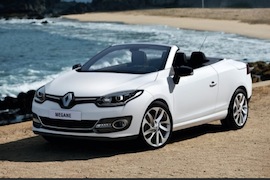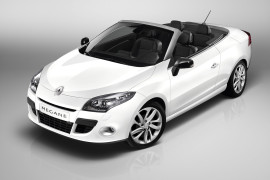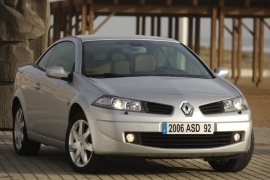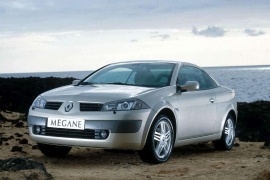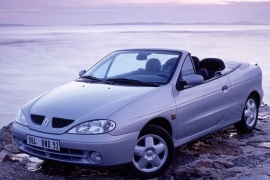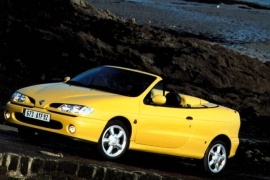RENAULT Megane Cabriolet Models/Series Timeline, Specifications & Photos
First production year: 1997
Engines: Gasoline, Diesel
Body style: Convertible (spider/spyder, cabrio/cabriolet, drop/open/soft top)
Renault unveiled the facelifted, open-top version of the Megane range in 2013 and started to sell it in 2014, promising an enjoyable experience by adding a new front fascia and more technology inside.
With the new Euro6 emission standards coming, the French carmaker had to make its move in the compact segment and introduced the refreshed Megane range. But it wasn't only the hatchback or the station wagon that went through this process. Even though the convertible market was not such significant, the carmaker kept its promise and brought the rejuvenated version of this model as well.
The new front fascia dropped the boomerang-style headlights from the Megane range, which lasted from 2010. Moreover, the front fascia sported a slimmer grille and a larger badge that took center stage. To help cool the engine, the carmaker added a wider grill in the lower bumper, flanked by the foglights' clusters. On the sides, there were little changes from the windshield to the back, but it installed tinted taillights. Also, the rear bumper was changed, adding a splitter in the lower center section.
Inside, like its predecessor, the Megane Coupe-Cabriolet offered room for four on a pair of bucket seats at the front and a bench in the rear. But unfortunately, there was hardly any legroom left for those seated in the back due to the retractable hard-top compartment. On the other hand, the driver was spoiled with an optional navigation system that could have been ordered and installed in the middle of the dashboard.
Under the hood, Renault chose to install a turbocharged 1.2-liter powerplant. The downsizing trend forced the French carmaker to do that, but it also offered a 2.0-liter naturally aspirated unit. Moreover, there was also a choice of turbo-diesel engines.
The Renault Megane Coupe-Cabriolet was the last addition to the Megane family and it was shown at the Geneva Motor Show in 2010. It was the second generation of the retractable roof Megane.
The third generation of the Megane had a retractable hard-top, like its predecessor. It was the sixth bodywork offered for the French compact range. To add even more refinement, the top featured a glass over the front passengers.
This high-gloss finish black glass roof contrasted with the satin-effect chrome windscreen frame, while the sweep of the waistline. The dark red taillights featured a linear lighting pattern and LED brake lights for a distinctive rear lighting signature. The transformation from coupe to cabriolet and back took only 21 seconds, and it was completely automatically. The driver didn't have to lock or unlock some levers above the raked windshield.
The car interior was based on the Megane Coupe version, with a mixed instrument cluster of dials and a display for the speedometer. The navigation and infotainment display was installed on top of the dashboard, in the middle and it could be controlled via commands on the center console. The car featured standard Bluetooth connectivity and a USB connection for an MP3 Player.
Under the hood, Renault offered six engine choices mated to either a manual, a CVT, or a dual-clutch gearbox.
Renault introduced a mid-life cycle refresh for its compact segment contender, the Megane, which included the three-years-old Coupe-Cabriolet version.
While Volkswagen refreshed the Golf VI on the same platform as the Golf V and called it a new generation, Renault took another path. It introduced the 2006 facelifted Megane but with almost no changes at all. It took a keen eye for detail to spot the differences between a 2004 Megane CC and its 2006 sibling.
On the outside, the 2006 Megane CC sported body-colored plastic moldings over the bumpers and sides, black on the 2003 version. Other than that, the carmaker installed the same angular headlights that were continued on the same line with the black grille. On the lower side of the front bumper, the carmaker installed round fog lights as standard for the entire range.
Inside, the carmaker introduced a new navigation system as an option. That featured a retractable screen on the top of the dashboard. Renault just carried over its instrument cluster with silver rings around the speedometer and tachometer from its non-facelifted sibling.
Under the hood, the French carmaker matched the engine with the Euro 4 emission standards. There was a new, 1.5-liter turbo-diesel version that offered an excellent fuel efficiency. A new addition was the 2.0-liter turbo-diesel carried over from the Laguna lineup that provided 150 hp.
Renault Megane was in its second generation, and the French automaker tried to offer it in as many versions as possible; moreover, it joined the coupe-cabriolet arena.
In the mid-2000s, many European automakers started to join the coupe-cabriolet trend. Besides Peugeot and Mercedes-Benz, who were the firestarters of this segment, Renault tried its luck too. Thus, it could provide the coupe and the open-top versions in a single vehicle. Convertibles were appreciated in the sunny sides of Europe, while coupes were demanded by those living in Northern areas. That was easy to understand. Yet, those from the colder countries could sometimes enjoy an open-top vehicle, but not so often. In addition, a solid roof could better protect a car from elements and provide better thermal insulation.
Sporting the same front fascia as the rest of the Megane range, the Coupe-cabriolet version came with a different styling from the A-pillars rearwards. They also had to serve as a protective safety arch and, in addition, allow for a raked windshield. Since there was no B-pillar, the overall profile looked clean and elegant. At the back, Renault carried over some parts from the rest of the Megane range.
Inside, customers could enjoy both open or closed-top trips. Moreover, Renault offered a panoramic glass roof, so the cabin was warmed by natural lights on cold but sunny days. When retracted, the greenhouse disappeared behind the rear bench, with limited room for two adult passengers. Unfortunately, the car had to be stopped to open or close the roof. Yet, it took only 20 seconds to complete any of these two operations.
Under the hood, Renault provided a wide choice of diesel or gasoline engines. But unfortunately, the car was quite heavy, so fuel efficiency was not exactly one of the vehicle's qualities.
Renault upgraded the Megane lineup in 1999, preparing it for the Euro 3 emission standards, and included the open-top version in the process.
The first generation of the Megane was a huge success, and it was one of the cars with the most extensive body versions ever made. Renault built it as a coupe, a convertible, a five-door hatchback, a sedan, a station wagon, and a minivan.
Along with the enhanced version, the Megane Cabriolet received a revised front fascia. Its grille featured larger vents. Its tear-shaped headlights with clear turn signal lights looked similar to those from the rest of the Megane range. The bumper featured a lower grille with horizontal and vertical slats. Apart from the body-colored door handles, the design team finished its job before it reached the back of the car, which remained unchanged.
The cabin received four seats, but the owner could have used only the front ones for passengers. Due to the short wheelbase and the pushed-forward rear bench, there was no legroom in the back. A profiled tonneau cover protected the manually operated fabric roof away from the sun.
Under the hood, Renault installed a choice of gasoline engines ranged between 95 hp and 150 hp, carried over from the coupe. It paired them with five-speed manual transmissions only.
Renault introduced the first Megane lineup in 1995 but waited for another two years before unveiling the Cabriolet version.
When Ford introduced the first open-top version for the Escort, it became an unexpected fashion item. Renault tried the same with a rag-top model 19, but it didn't reach that status. After a few years, when the Megane was already a real success, the French carmaker tried again. It took the little Megane Coupe, reinforced its structure, and cut its roof resulting in the Megane Cabriolet.
With its already known front fascia that sported the bird-beak design with an arched, vertical slat on the grille, the Megane screamed for attention. However, its short hood and very raked windshield were adequate for an open-top version. Moreover, the short cabin meant that, apart from the windscreen, the car didn't need any other roll-cage to protect its occupants. Renault worked hard to make room for the canvas roof behind the rear seats. After the passenger area, the car featured a short, double-bubble deck and the trunk lid.
Concealing the rag top might be a good idea for a longer car, but on the Megane coupe, that came with the cost of two unusable rear seats. It wasn't kind to put a person there or any animal larger than a golden fish in a bowl. But Renault knew that its customers wouldn't use that space for anything else other than a storage area for a shopping bag or two. So yet, it provided comfortable, high-bolstered front bucket seats with velour upholstery on the standard version and an option for a leather-clad interior.
Under the hood, the carmaker axed the 1.4-liter base engine from the Megane lineup and offered the Cabriolet version with a choice of three gasoline engines. These ranged between 90 hp and 150 hp, making the little open-top vehicle an excellent daily driver, especially in cities. But unfortunately for the French carmaker, that version wasn't as successful.
